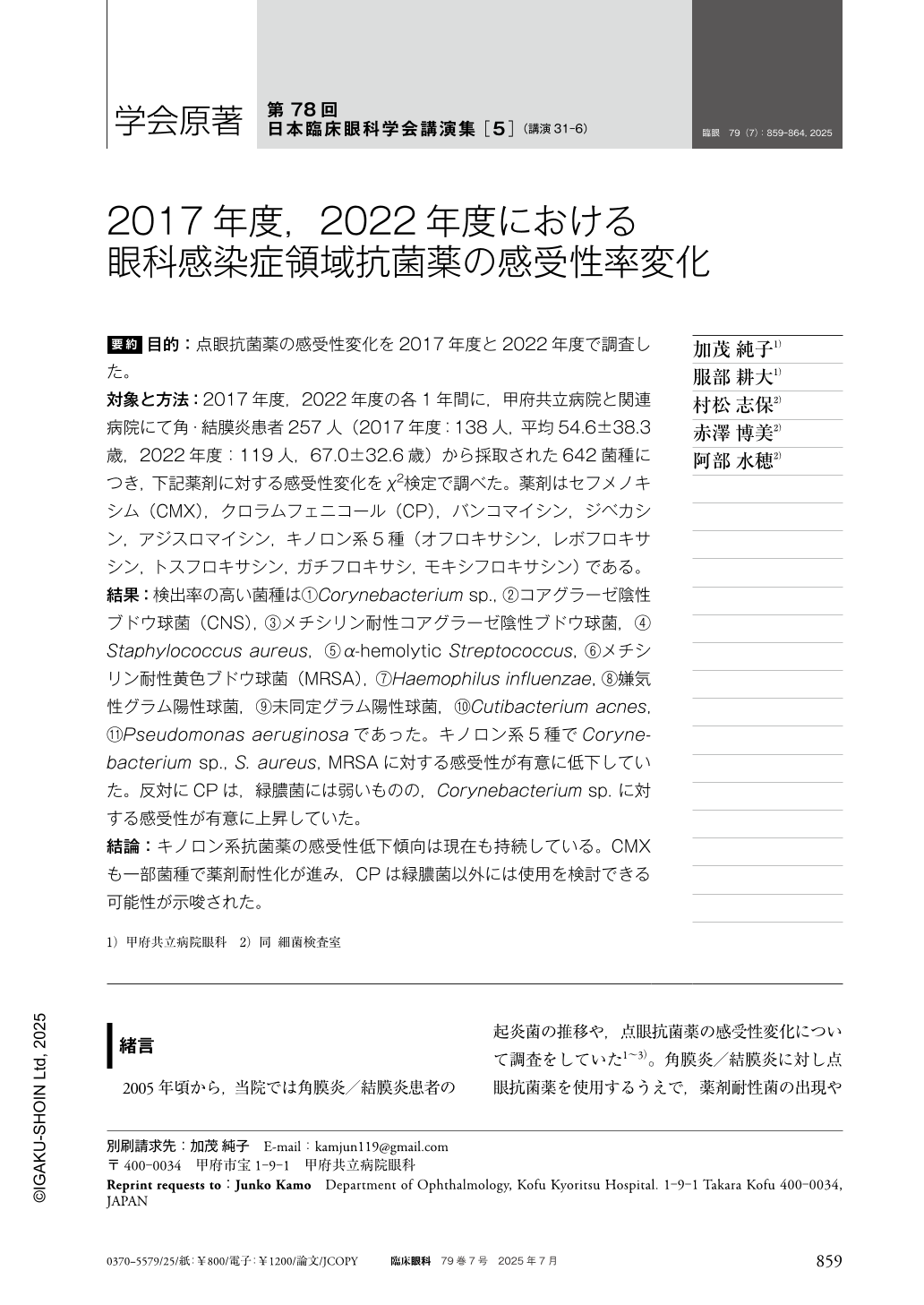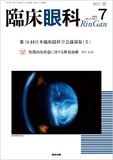Japanese
English
- 有料閲覧
- Abstract 文献概要
- 1ページ目 Look Inside
- 参考文献 Reference
要約 目的:点眼抗菌薬の感受性変化を2017年度と2022年度で調査した。
対象と方法:2017年度,2022年度の各1年間に,甲府共立病院と関連病院にて角・結膜炎患者257人(2017年度:138人,平均54.6±38.3歳,2022年度:119人,67.0±32.6歳)から採取された642菌種につき,下記薬剤に対する感受性変化をχ2検定で調べた。薬剤はセフメノキシム(CMX),クロラムフェニコール(CP),バンコマイシン,ジベカシン,アジスロマイシン,キノロン系5種(オフロキサシン,レボフロキサシン,トスフロキサシン,ガチフロキサシ,モキシフロキサシン)である。
結果:検出率の高い菌種は①Corynebacterium sp., ②コアグラーゼ陰性ブドウ球菌(CNS), ③メチシリン耐性コアグラーゼ陰性ブドウ球菌,④Staphylococcus aureus,⑤α-hemolytic Streptococcus, ⑥メチシリン耐性黄色ブドウ球菌(MRSA),⑦Haemophilus influenzae, ⑧嫌気性グラム陽性球菌,⑨未同定グラム陽性球菌,⑩Cutibacterium acnes, ⑪Pseudomonas aeruginosaであった。キノロン系5種でCorynebacterium sp., S. aureus, MRSAに対する感受性が有意に低下していた。反対にCPは,緑膿菌には弱いものの,Corynebacterium sp. に対する感受性が有意に上昇していた。
結論:キノロン系抗菌薬の感受性低下傾向は現在も持続している。CMXも一部菌種で薬剤耐性化が進み,CPは緑膿菌以外には使用を検討できる可能性が示唆された。
Abstract Purpose:This study aimed to investigate the changes in susceptibility of ocular bacterial pathogens to antibiotic eye drop in 2017 and 2022.
Subjects and methods:A total of 257 patients with conjunctivitis(138 in 2017, mean age 54.6±38.3 years;119 in 2022, mean age 67.0±32.6 years) were enrolled from Kofu Kyoritsu Hospital and affiliated hospitals. From these patients, 642 bacterial isolates were collected in 2017 and 2022 and tested for changes in antibiotic susceptibility using chi-square test. The antibiotics examined were cefmenoxime(CMX), chloramphenicol(CP), vancomycin, dibekacin, azithromycin, and five fluoroquinolones(ofloxacin, levofloxacin, tosufloxacin, gatifloxacin, and moxifloxacin).
Results:The bacterial species with the highest detection rates were:1. Corynebacterium sp., 2. coagulase-negative staphylococci, 3. methicillin-resistant coagulase-negative staphylococci, 4. Staphylococcus aureus, 5. α-hemolytic Streptococcus, 6. methicillin-resistant Staphylococcus aureus(MRSA), 7. Haemophilus influenzae, 8. gram-positive anaerobic cocci, 9. unidentified gram-positive cocci, 10. Cutibacterium acnes, and 11. Pseudomonas aeruginosa. The five fluoroquinolones demonstrated a significantly decreased susceptibility to Corynebacterium sp., S. aureus, and MRSA. Contrarily, CP remained ineffective against P. aeruginosa;however, its susceptibility to Corynebacterium sp. was significantly increased.
Conclusion:The trend of decreased susceptibility to fluoroquinolone antibiotics persists to the present day. Drug resistance to CMX has also increased in certain bacterial species, suggesting that CP may be a useful alternative for treating infections caused by organisms other than P. aeruginosa.

Copyright © 2025, Igaku-Shoin Ltd. All rights reserved.


